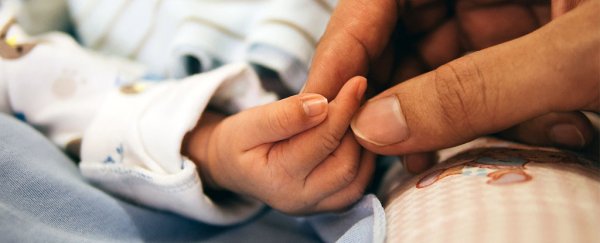Losing a baby before birth is tragic, so research investigating the potential risks and prevention of stillbirth is incredibly important.
Now a UK study has found a link between increased risk of stillbirth and a common sleep position - adding more data to the idea you should try to sleep on your side during the last trimester of pregnancy.
A team of researchers led by obstetrician Alexander Heazell at Tommy's Stillbirth Research Centre, University of Manchester has just published the largest study investigating maternal sleep position and stillbirth risk.
Small-scale studies in New Zealand and Australia have already indicated a link between sleeping on the side and decreased stillbirth risk. To investigate that link further, researchers recruited a larger number of women than ever before.
The team interviewed 1024 women from 41 maternity hospitals across the UK - 291 of them had a stillbirth late in the pregnancy, and 733 had a live-born baby.
They tested the hypothesis that there's a link between the position in which a pregnant woman goes to sleep and whether she ends up having a stillbirth late in the pregnancy.
And the data showed an association, finding that going to sleep on the back instead of sleeping on the side was associated with a 2.3-fold increased risk of late stillbirth.
"This study suggests that 3.7 percent of stillbirths after 28 weeks of pregnancy were linked with going to sleep lying on the back," the team writes in the paper.
"This study also shows that the link between going-to-sleep position and late stillbirth was not affected by the duration of pregnancy after 28 weeks, the size of the baby, or the mother's weight."
Since the study was a prospective investigation and didn't test any potential causes for the link, it's not entirely clear why that might be the case, but the team has some ideas.
It's possible that late in the pregnancy, when a woman is asleep on her back, the weight of the womb puts pressure on the blood vessels supplying the baby with oxygen. Sleeping on the back can also cause more breathing problems in general.
Despite being unable to explain the precise mechanism, the team thinks the data is enough to recommend sleeping on the side - especially because it's not the kind of thing we can ethically or practically test with experiments.
But the researchers are also quick to note they're not trying to freak anyone out.
"What I don't want is for women to wake up flat on their back and think 'oh my goodness I've done something awful to my baby'," Heazell told the BBC.
According to him, we spend the longest period of time in the position we fall asleep in, so that's the one the team investigated, and it's the one that matters most.
"[Y]ou can't do anything about the position that you wake up in, but you can do something about the position you go to sleep," he added.
So what's the advice? According to information from Tommy's Stillbirth Research Centre, here's what women can do in the last three months of their pregnancy:
- Put a pillow or pillows behind your back to encourage side-sleeping.
- If you wake during the night, check your position and go back to sleep on your side.
- Pay the same attention to sleep position during the day as you would during the night.
"Stillbirth is devastating, with long-lasting effects on bereaved parents. Parents want to know why their baby has died, whether it might happen again if they try for another baby and what they can do to avoid further stillbirth," says Heazell.
"We believe that identifying, and avoiding, risk factors that are strongly associated with stillbirth will reduce the number of babies who are stillborn."
The study was published in the International Journal of Obstetrics and Gynaecology.
Tommy's research centre has also launched a Sleep On Side campaign to raise awareness about these findings, and you can watch the video here:

